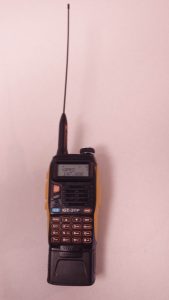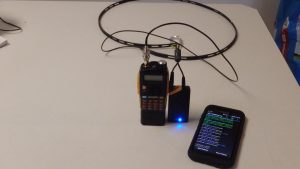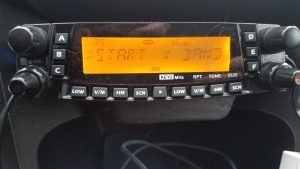Hiking with Ham Radio
One of the biggest challenges with amateur radio, or ham radio, is communicating over mountainous terrain in remote regions. Natural obstacles, lack of other nearby repeaters, and logistical limitations make backpacking or hiking while operating a ham radio difficult. For someone who is new to ham radio these technical challenges can be daunting. There is plenty of information on radio specifications, repeater frequencies, and ways to overcome natural barriers on the Internet. However, the majority of resources are spread out, requiring a new ham radio operator to spend dozens of hours on research before deciding if they should bring a ham radio on a backpacking trip. This article will discuss the different ways you can overcome the many challenges that hiking with a ham radio brings. First, I’m going to cover the most important step to operating a ham radio- licensing.
You must be licensed to transmit on any frequency that is restricted by the FCC for amateur radio use. Although some might find this requirement to be intimidating, there are many resources available for new hams, such as the exam questions themselves. In addition, there is probably an exam happening near you soon. There are three different types of amateur radio licenses: technician, general, and extra. For most hikers, all you need is a technician license to be able to successfully communicate in the backcountry. VHF repeaters are extremely common, and VHF reception is adequate in many remote areas. That being said, a general license will give you the most flexibility with equipment selection, and available frequencies. An extra license would be overkill in many cases, but if you’re an over-achiever, go for it! Once you have your radio license, it’s time to talk about radios.
With ham radio equipment, the size and weight of a radio is proportional to the amount of power it has. To put it simply, smaller may be better for backpacking, but you’re going to give up features and reception. The best compromise for backcountry communication will be a handheld radio such as the BaoFeng BF-F8HP, or BaoFeng GT-3. Portable radios are the bulkiest and heaviest (8 lbs is typical), while a handheld radio will weigh less than a pound. Most portable radios will allow you to communicate over HF frequencies (allowing you to overcome natural barriers, in many cases), while handheld radios can be useless in certain areas (narrow canyons, for example). Most handheld radios will only transmit VHF/UHF, your goal with these radios is to reach a repeater (which are often conveniently located on mountain tops or tall hills), so that your weak signal can be retransmitted to other ham users in the area. Coverage with a VHF radio typically maxes out at around 50 miles, while a HF radio can communicate for hundreds or thousands of miles. Any radio you pick out will need to have another critical component- a good antenna.
Handheld radios are great VHF/UHF radios, and their transmit power has increased dramatically thanks to innovation and higher capacity batteries. However, the portability of these radios does have one major drawback- the antenna that comes with these units is not suitable for backcountry ham radio use. There’s an easy fix for this, though- an aftermarket replacement antenna. For backcountry use, the DBJ-2 By Dr. Ed Fong works well- it’s compact when stored in your backpack, and rolls out to three feet long, making it a great ½ wavelength antenna. It’s extremely common for me not to be able to reach repeaters with the stock antenna on my handheld radio, only to receive positive signal reports while using the DBJ-2 antenna. Now that you’ve got a decent handheld radio, and a great antenna to go with it, you should be all set to hit repeaters in your area with your setup. However, not every mountain range is the same, and not every area has the same RF coverage- what happens if you still can’t reach local repeaters with your setup? Now, it’s time to get creative.
If your handheld radio still can’t contact a local repeater with a good antenna, it doesn’t make much sense to take your radio with you, does it? Before you get frustrated with ham radio, there are still a few options left. First, you can buy or make a good Yagi, a directional antenna. This would allow you to reflect the energy from your radio off of mountains, where they would then strike your local repeater (using knife edge diffraction), or it could be used to point in the direction of your local repeater, if obstacles are not a problem. Let’s say that you’ve tried all of these antenna tricks though, and you still have no reception in the wilderness- what then?
At this point, you’re running out of options. You’re going to need to spend some money either way, and while no one wants to spend money if they don’t have to, the next two solutions will work in most situations. You’ll need to purchase another radio, antenna, and possibly an extra battery, with either of the next two solutions. The main differences between these two solutions are the complexity of the setup, overall weight in your back, and availability of VHF repeaters in the area you want to hike in.
If you can access a VHF repeater in the trailhead parking lot, but lose the signal once you start down the trail, you can install an extra radio in your vehicle and use cross band repeat mode on that radio. Cross band repeat works by connecting to your local VHF repeater, and then rebroadcasting that signal on a UHF frequency. I wrote a separate article about cross band repeat mode, including how to set it up, in an article titled Using Cross Band Repeat while Backpacking. The upside to this setup is that you will get an increased range, without adding an ounce to your backpack. When backpacking, weight is king, so many backpackers choose this route. In some areas though, VHF repeaters are not accessible from the trailhead. If you find yourself in this situation, and still want to use ham radio for backcountry communication, it’s time to upgrade your gear.
With VHF and UHF frequencies, reception is limited to line of sight, typically. With lower frequency (HF) bands, and even the 6 meter band, this limitation disappears. HF radios take you from 50 miles to hundreds of miles, with decent reliability. With the increased communications range comes a price, though. HF antennas are huge compared to VHF antennas (tens of feet long, at least), and the radios start at about 7 lbs. Many backpackers view this as a last resort, due to the difficulty of raising such a large antenna (especially if you’re injured), as well as the added weight of the HF radio. If you’re out of options, a HF radio is better than no radio though, and you have the added bragging ability of being able to make contacts across the globe, while in the wilderness.
One last technology that is useful while backpacking is APRS, or Automatic Packet Reporting System. APRS is designed so that you can transmit short messages about your position, condition, or even just about how your day was, to your loved ones via an email service. EMAIL-2 takes any message that you send it, and relays it to the destination that you specify- which with most cellphone carriers can be an email address. In order for you to use APRS, your radio must support it (you can purchase a TNC module for your radio, if it doesn’t natively support APRS), and you must have excellent reception to an APRS digipeater. I’ve written more about using APRS in this article titled, Backpacking with APRS. If you’re interested in using APRS, read that article– it will explain the advantages, drawbacks, and best practices to get APRS working in the backcountry.
Hiking with a ham radio requires special equipment, expertise, and sometimes luck. With a reliable setup that has been field tested before your backpacking trip, you’ll be amazed how easy everything comes together, and how easy it is to contact the outside world. That being said, you will need to test your equipment many times before you head into the wilderness. Ham radio can be finicky at times, and you want all of the “bugs” worked out with your setup before you hit the trail.





